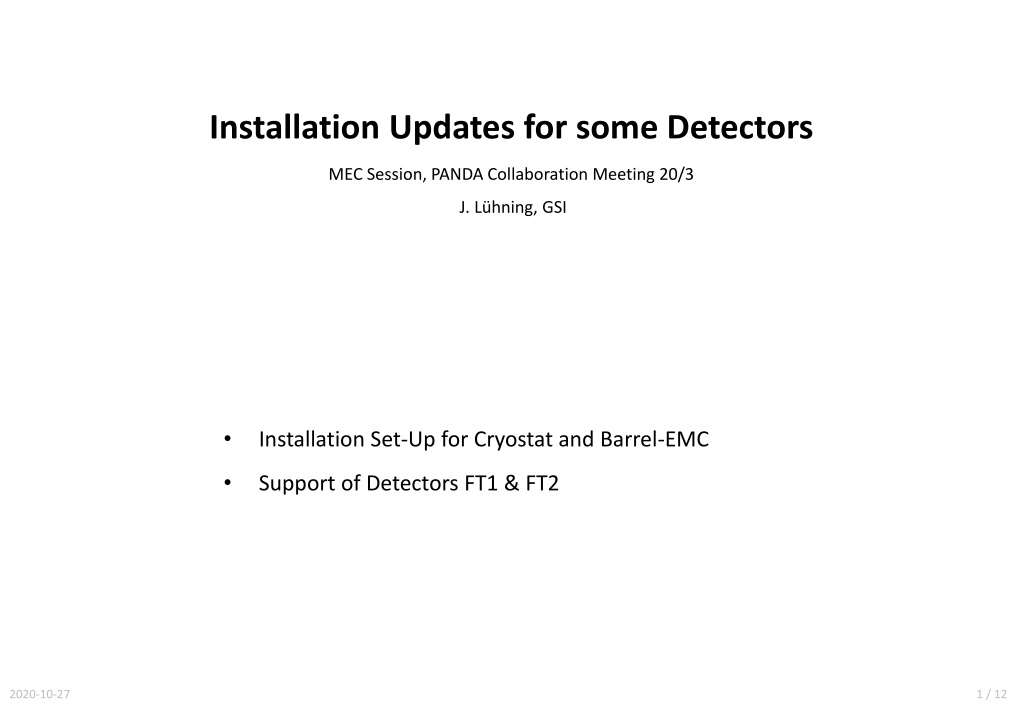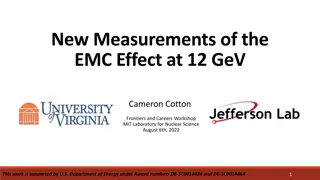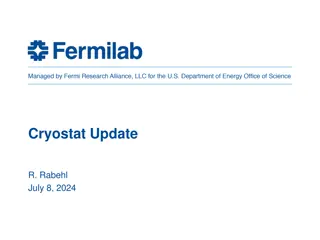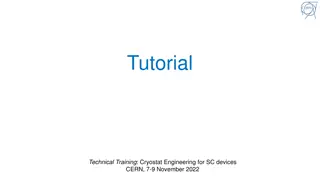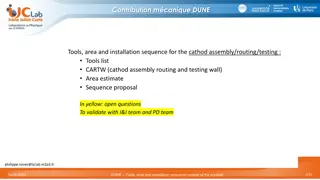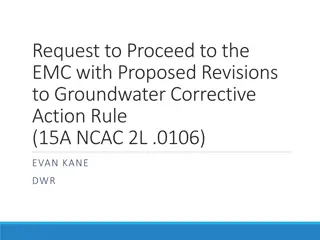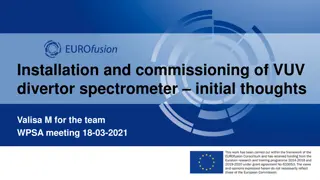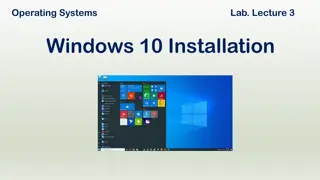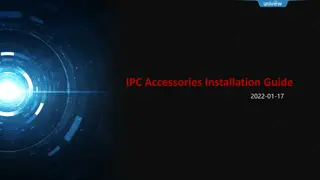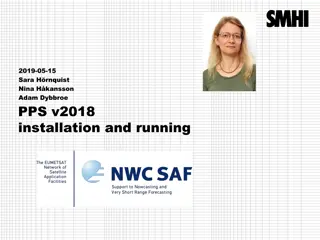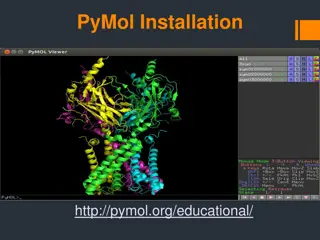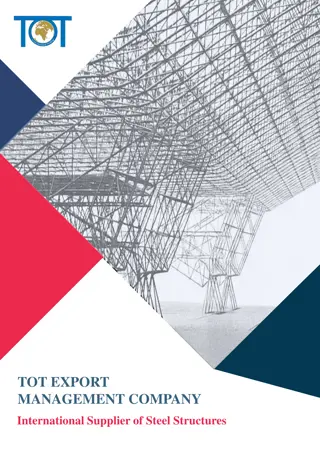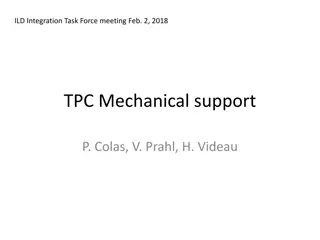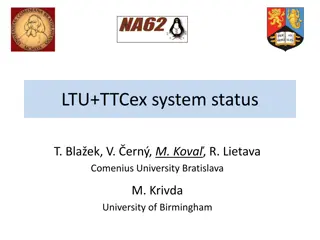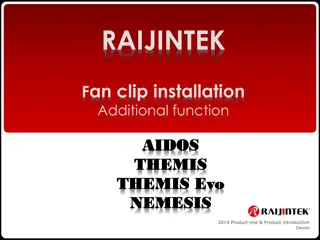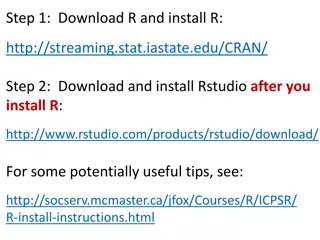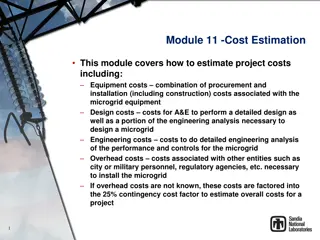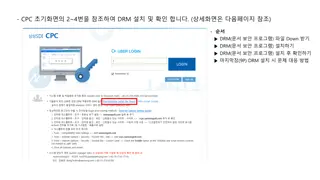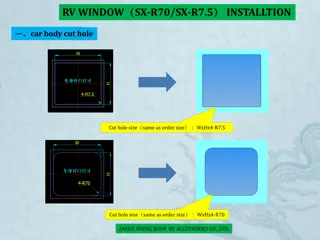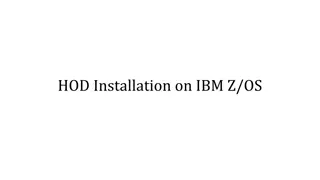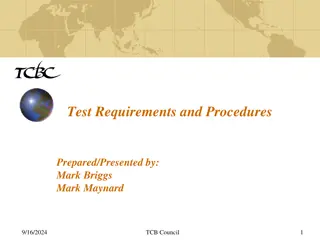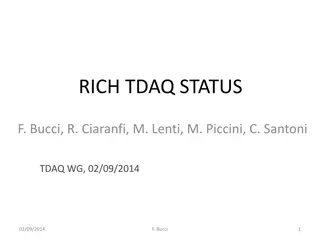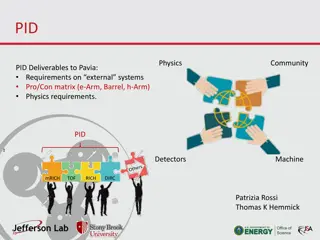Installation Updates for Cryostat and Barrel-EMC Set-Up
Here are installation updates for detectors at the MEC session and PANDA Collaboration Meeting, including the design and setup by Sergey Pivovarov for installing the cryostat and barrel-EMC. The process involves moving the I-beam, fixing supports, and positioning the cryostat within the barrel yoke. Detailed steps and images are provided for clarity.
Download Presentation

Please find below an Image/Link to download the presentation.
The content on the website is provided AS IS for your information and personal use only. It may not be sold, licensed, or shared on other websites without obtaining consent from the author. Download presentation by click this link. If you encounter any issues during the download, it is possible that the publisher has removed the file from their server.
E N D
Presentation Transcript
Installation Updates for some Detectors MEC Session, PANDA Collaboration Meeting 20/3 J. L hning, GSI Installation Set-Up for Cryostat and Barrel-EMC Support of Detectors FT1 & FT2 2020-10-27 1 / 12
Installation Set-Up for Cryostat and Barrel-EMC Sergey Pivovarov (BINP) has designed a set-up for installing the cryostat in the solenoid yoke. This design is available as STEP file in EDMS. The set-up essentially consists of a 9 meter long I-beam and 3 supports. It was designed so strong that with minor modifications it can be used for installing the barrel-EMC (weight 20 tons) which is heavier than the cryostat. For the installation of the cryostat the I-beam needs to be 20 centimeters higher than for the installation of the EMC. The following slides show a possible installation scenario. 2020-10-27 2 / 12
1. The I-beam (marked orange) will be moved into the barrel yoke by crane from the upstream side. For this operation, the upstream support should already be fixed to the I-beam. The I-beam and the attached upstream support weigh about 3.2 tons. Their centre-of-gravity is about 2.3 meters away from the upstream end of the I-beam. Crane ropes fastened at the centre-of-gravity (marked green) will stay outside of the barrel yoke, thus allowing to move the I-beam into its designated position without having to use other means than the crane. The blue blocks (height 20cm) beneath the feet of the supports are only needed for the installation of the cryostat. 2020-10-27 3 / 12
2. The mid support will be fixed to the I-beam, and the upstream support will be removed. 2020-10-27 4 / 12
3. The cryostat (still on its support frame, marked turquoise) will be moved onto the I-beam by crane. 2020-10-27 5 / 12
4. The upstream support will again be fixed to the I-beam, the mid support will be removed, and the cryostat will be moved into the barrel yoke. 2020-10-27 6 / 12
5. The cryostat will be fixed to the barrel yoke in the designated position. 2020-10-27 7 / 12
6. All blocks beneath the feet of the 3 supports will be removed, the I-beam will be lowered by 20cm. In this position the mounting of the barrel-EMC can be started. 2020-10-27 8 / 12
A side-support height of 331cm allows to use the supports for installing both the cryostat and the barrel-EMC. The width of the side supports is assumed to be 180cm. Concerning seismic events on the FAIR site we assume that a set-up will be save if any (virtual) static horizontal acceleration of 1.2m/s (12% of earth gravity) will not lead to excessing the ultimate tensile strength of any material anywhere. Static FEM simulations have been carried out to check the seismic safety of the set-up. In addition to earth gravity a static horizontal acceleration of 1.2m/s had been applied to all masses in various directions, with the main mass (20 tons) in various positions on the mounting beam. 2020-10-27 9 / 12
Load case example: 20-tons EMC (a dummy here) in upstream position, with mid support, horizontal force 12 weight-% normal to the I-beam axis (towards the viewer) Von-Mises-stresses / MPa Not in any simulation of load cases the ultimate tensile strength ( 360 MPa for mild construction steel) was exceeded. In very few regions only the yield strength of construction steel ( 240 MPa) was exceeded. 2020-10-27 10 / 12
Support of detectors FT1 & FT2 The obviously best place to mount the first two Forward Tracker detectors is the upstream field clamp. When the dipole will be ramped to full nominal current then the upstream field clamp will be attracted by a force in the order of 10 tons (100kN). The support of FT1 & FT2 has to be connected to the field clamp in such a way that the deflection of the field- clamp will hardly cause any deflection on the Tracker detectors. In order to achieve this the connections of the support frame to the field clamp should be in the height range of the rigid field clamp supports, which will hardly change their positions. If the connection would be near to the upper end of the clamp support then it would be advantageous to choose a pin- jointed connection as shown in the figure to the left (free rotational degree- of-freedom about the x-axis, yellow pin/bolt cut for better visualization) . support frame for both FTs pin-jointed connection between field- clamp and support frame field clamp plate 50mm field clamp support dipole yoke field clamp plate 30mm Simplified FEM model, for symmetry reasons one half (the western half) 2020-10-27 11 / 12
Color scale: Deflection of field-clamp and Tracker detectors in Z- direction (beam direction) The maximum deflection of the field clamp will be almost half a millimeter. In the shown configuration the maximum deflection of the straw-tube planes will only be 0.040 mm in z-direction and 0.018 mm in vertical direction. If the upper connection shown on the previous slide would not be pin-jointed but completely fixed then the maximum deflection of straw-tube planes will be 0.066 mm in z-direction. Deflection of field-clamp and Tracker detectors, magnification factor 500 2020-10-27 12 / 12
